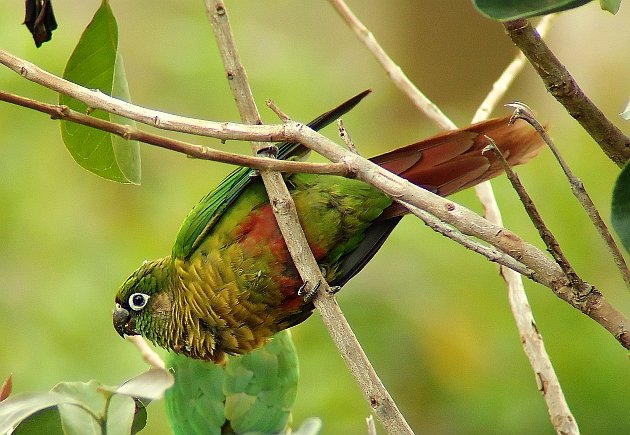
Parrots captivate me more than any other bird family. I am a self-proclaimed psittacophile. For one, they are remarkably diverse with a little over 380 species spread over every continent except Europe (only introduced) and Antarctica. Second, they occupy an astonishing variety of habitats from temperate Araucaria forests in Chile to alpine scree in New Zealand to seasonally flooded rainforests in Brazil to rocky sea cliffs in Australia. With their strong flight and capability to disperse, parrots have managed to colonize almost every major island group from Tahiti to Mauritius to Dominica. There are nectar feeders, dedicated frugivores, specialized seed predators and more. There seems to be a parrot for almost any ecological situation. However, they do not occur evenly across their familial distribution. Nearly all the diversity occurs in either the Neotropics or Australasia. Brazil, in particular, is the country with the largest number of parrot species in the world with approximately 84 species. By contrast, Australia, often considered to be the land of parrots, has approximately 54 species. In my experience, parrots form a visibly and numerically important component of the Brazilian bird fauna. Let us see what this country has to offer when it comes to these colorful avian clowns.
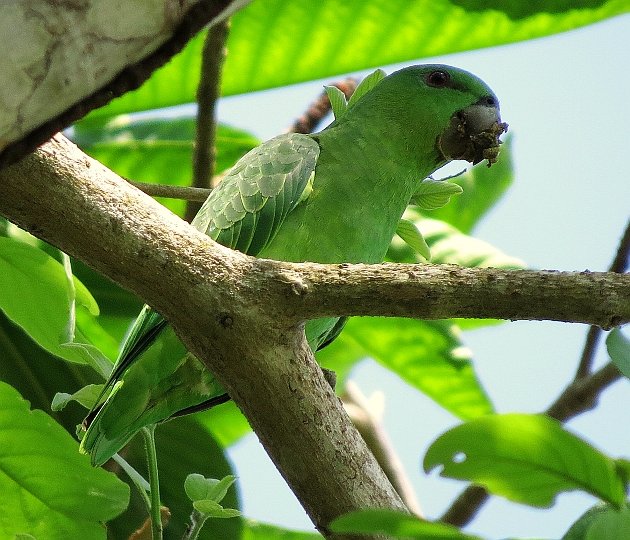 The mostly green Short-tailed Parrot is a river island specialist, photo courtesy of Eduardo Patrial.
The mostly green Short-tailed Parrot is a river island specialist, photo courtesy of Eduardo Patrial.
No other region in Brazil has so many parrots as the Amazon. A morning watch from a canopy tower such as at Cristalino Lodge provides an excellent vantage point from which to see the daily commute of macaws, parakeets and parrots from their roosting areas to their feeding areas. Scarlet, Red-and-green and Blue-and-yellow Macaws are an obvious highlight, loudly announcing themselves as they elegantly fly past. Although nearly all are colorful, parrots are actually quite conservative when it comes to extravagant plumes. The Red-fan Parrot breaks the mold by having elongated red feathers with purple tips that it can erect to form a spectacular mane around the head. River islands and varzea forest, both dynamic, seasonally flooded habitats within the greater Amazonian ecosystem, support their own set of special parrots. The monotypic Short-tailed Parrot is one of these species, occurring only swampy forests and river islands right along the Amazon River and wider sections of its largest tributaries.
Being so vast and difficult to access, the Amazon Rainforest also contains several recently described species such as Kawall’s Parrot. Although known to exist since the early 1900s, scientists believed that these strange parrots were only aberrant Mealy Parrots until aviculturist Nelson Kawall helped determine that it was a legitimate species in the 1980s. The Bald Parrot has an even more interesting history of discovery. Being closely related to the Vulturine Parrot, scientists believed that these birds were just juveniles of that species until specimens were captured and studied in the late 1990s. The Bald Parrot was only described as a separate species in 2002. What other secrets does the Amazon still hold?
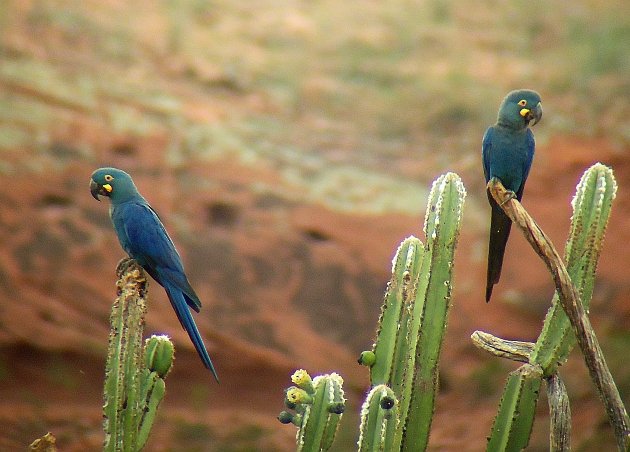 Lear’s Macaw near red sandstone cliffs in Bahia, photo courtesy of Eduardo Patrial.
Lear’s Macaw near red sandstone cliffs in Bahia, photo courtesy of Eduardo Patrial.
In the northeast of Brazil, the dry thorn-scrub caatinga is the home of the endangered Lear’s Macaw with a total population of only 1,100 birds. Formerly a long-standing mystery, Helmut Sick discovered the first wild populations of this parrot in a remote corner of Bahia state in 1978. Interestingly, they nest exclusively in the red sandstone cliffs where they occur. The arrival of these large, vibrant blue birds at dusk with the red sandstone cliffs as a backdrop must be a sight to behold.
Further south and west, the Pantanal is the last stronghold for the endangered Hyacinth Macaw, the largest flying parrot in the world. A close relative of the Lear’s Macaw, their numbers are increasing in the Pantanal where they are now easy to see. These birds have an unusual ecological relationship with the Toco Toucan. Although they are major nest predators, these large toucans also disperse the vast majority of the Sterculia tree seeds that germinate. Sterculia is the nesting tree of choice for the cavity nesting Hyacinth Macaws.
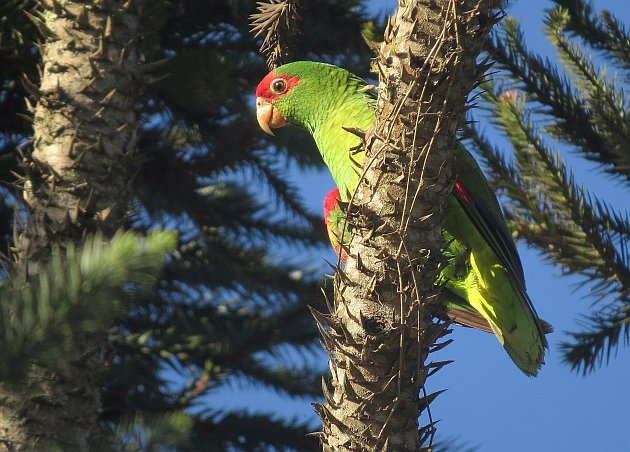 Red-spectacled Parrots roost in Araucaria groves in the thousands, photo courtesy of Eduardo Patrial.
Red-spectacled Parrots roost in Araucaria groves in the thousands, photo courtesy of Eduardo Patrial.
The Atlantic Rainforest of Brazil is a major hotspot for endemism. Long separated from the Amazon Rainforest by the dry corridor formed by the cerrado and caatinga, birds here are completely different from those found on the rest of the continent. Through centuries of deforestation, only 7% of this forest’s original area remains in remnants scattered within the most densely populated region of Brazil. Some species manage to adapt to the urbanization of the landscape such as White-eyed and Plain Parakeet (although common, it is a Brazilian endemic). Most do not. The beautiful Red-tailed Parrot ranges only in a narrow strip of littoral forest along the coasts of the states of Parana and Sao Paulo while the partially migratory Red-spectacled Parrot roosts during the non-breeding season in only a handful of Araucaria (monkey puzzle) groves in southern Brazil. Both of these endemic parrots suffer from habitat loss and trapping for the pet trade.
No discussion of Atlantic Rainforest parrots can fail to include the monotypic Blue-bellied Parrot, one of the most unique parrots in the Americas. At first glance, this is a conservative, mostly green parrot with a lightly colored bill and a muted blue belly patch. In contrast to the harsh voices of most other parrots, this one sets itself apart by having a melodious, flute-like song. Brazilians call it sabia-cica in reference to its thrush-like song.
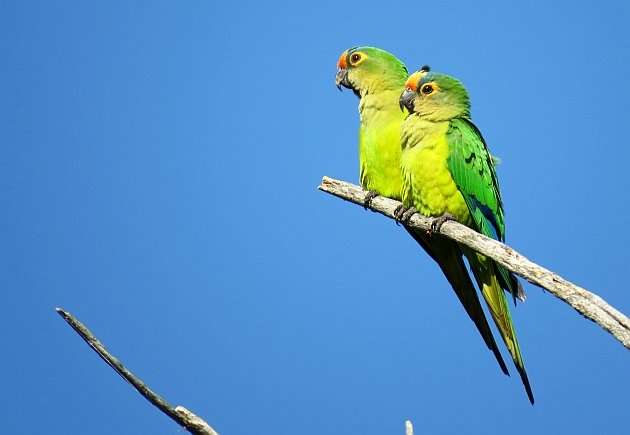 These Peach-fronted Parakeets are widespread and adaptable birds, photo courtesy of Eduardo Patrial.
These Peach-fronted Parakeets are widespread and adaptable birds, photo courtesy of Eduardo Patrial.
Perhaps more than in any other country in the Americas, parrots are a key component of the birding experience in Brazil from rainforests to wetlands to thorny desert. Although several species readily adapt to human disturbance and can be seen even in downtown Sao Paulo or Rio de Janeiro, Birdlife International currently lists eight parrot species (all endemic or near-endemic to Brazil) as endangered or critically endangered. Glaucous Macaw, although listed as critically endangered, is more than likely the country’s first extinct parrot while Spix’s Macaw is extinct in the wild. More than just the noisy green birds that screech overhead while you are birding in the Neotropics, parrots are a wonderful, diverse and troubled family that merits attention.













Interesting post with excellent photos. I love parrots and hope to see some of these one day. Thanks!
From the encouragement of birding friends and now after reading your post about Brazil’s parrots, I think it’s high time I make that first trip to this country.